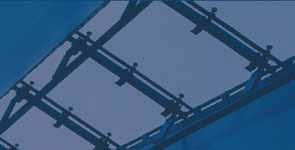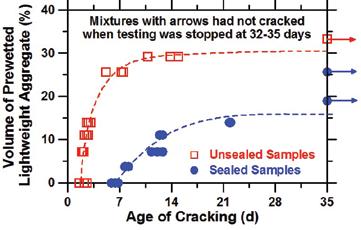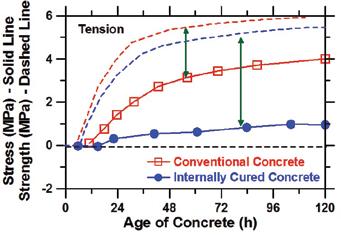
13 minute read
Construction Issues
discussion of construction issues and techniques External water Water penetration Normal Aggregate Prewetted LWA
Cured Zone
Conventional (External) Water Curing Internal Curing with Prewetted Lightweight Aggregate (LWA)
Figure 1: Comparison of external (conventional) and internal curing using pre-wetted lightweight aggregate (LWA) (*Note that in practice the prewetted lightweight aggregates are placed sufficiently close to enable the cured zones to overlap allowing the entire paste to be cured)
Constructing More Internal Curing It is often said that there are two types of concrete: concrete that has cracked and concrete that is going to crack. Unfortunately, Robust Concrete this is true all too frequently. Many of these unwanted cracks develop shortly after the By Jason Weiss, Dale Bentz, concrete is placed and, in addition to being Anton Schindler, P.E. and unsightly, can contribute to reduced long-term Pietro Lura durability. This cracking may be attributed to the fact that, unlike many other materials that are prepared in factories under relatively well controlled conditions, a large proportion of concrete is cast on site under a wide range of climatic conditions (wind, temperature, relative humidity). This article reviews some promising research that is reengineering conventional concrete mixtures to make them more robust, (defined by Webster’s Dictionary as capable of performing without failure under a wide range of site conditions) for field construction.
The online version of this article contains detailed references. Please visit www.STRUCTUREmag.org.
The Importance of Concrete Curing
To begin, remember that concrete is a nonhomogeneous material consisting of aggregate in a cement paste matrix. While the cement paste is initially a fluid suspension, it reacts (hydrates) over time causing it to solidify, thus binding (gluing) the aggregates together. If water is lost from the paste due to evaporation at early ages, there are two main consequences. First, the hydration reaction will slow and ultimately stop, which limits strength development and produces a more permeable material when compared with a sample that did not lose water. Second, the loss of water causes concrete to shrink and, if restrained, the concrete develops stresses that may lead to cracking. Conventional concrete construction relies on curing to reduce the potential for water loss. Some conventional approaches add water to the concrete surface (i.e., water ponding or misting) which can be absorbed (Figure 1), while other approaches focus on minimizing moisture loss (evaporation retarders, curing compounds, or plastic sheeting). Differences between providing additional water and preventing moisture loss become increasingly important for lower water-to-cement ratio (high-performance concretes), since they self-desiccate (loss of water in the concrete due to hydration which is similar to the effect of drying) as a result of hydration causing a (autogenous) shrinkage even without external moisture loss. While curing is commonly specified in concrete construction, it is an additional step that is all too often overlooked or done inadequately. Further, when long curing times are specified, the construction process can be slowed substantially. This may be the case, for example, when large volumes of supplementary cementitious materials (SCMs) are used. As a result, research has focused on determining whether curing can be changed from an external process to something that happens inside the concrete mixture. This new approach is called internal curing.
What is Internal Curing?
Internal curing has been defined by the American Concrete Institute (ACI) as “supplying water continued on page 12



Pass THE



STRUCTURAL EXAM
WITH CONFIDENCE!



Prepare for exam day success with this new course designed by the National Council of Structural Engineers Associations (NCSEA), Kaplan Engineering Education, and leading structural engineers from across the industry.
The exam underwent significant changes in April 2011, making it even more challenging. Be prepared with our online exam review course!
NCSEA Structural Engineering Exam Live Online Review Course
The targeted review includes: - Over 28 hours of instruction with an emphasis on building design - New sessions on exam strategy and bridge design - Key topics of structural code - Efficient analytical methods - New material in the 16-hour
Structural exam - Typical exam questions - Problem solving techniques - Exam day skills - 24/7 playback – study anytime
Every registered student will receive a Structural Engineering Learning System – a $194.95 value – FREE with the course. This system includes an updated Structural Engineering License Review Problems & Solutions textbook containing the new material added to the 16-hour Structural exam.
Live Online Course Dates: January 21 & 22 - Vertical Forces Review February 25 & 26 - Lateral Forces Review Course Fee: $1199 | Vertical or Lateral Only: $749
REGISTER TODAY! 1-800-420-1432

Figure 2: The relationship between the amount of internal curing provided (amount of LWA) and the age of cracking. Figure 3: A plot of stress development in restrained concrete at early ages for conventional and internally cured concrete.
throughout a freshly placed cementitious mixture using reservoirs, via pre-wetted lightweight aggregates, that readily release water as needed for hydration or to replace moisture lost through evaporation or self-desiccation”. While lightweight aggregate is discussed in this article and is the most common method used as a water reservoir, researchers throughout the world are also investigating the use of superabsorbent polymers and natural fibers. Differences between conventional (external) curing and internal curing are shown in Figure 1. While external curing water is applied at the surface and its depth of penetration is influenced by the quality of the concrete, internal curing enables the water to be distributed more equally throughout the cross section. While designing concrete specifically to provide internal curing is relatively new, the concept of lightweight aggregate improving the hydration of the cement paste was observed in the 1950s by Paul Klieger. Research on intentionally using lightweight aggregate for internal curing began to take shape in the late 1990s when a variety of research groups, primarily in Europe, began actively investigating whether mixtures could be designed with internal curing by using pre-wetted lightweight aggregates. Design procedures were then developed that enabled both the spatial distribution and amount of pre-wetted lightweight aggregate to be computed (Bentz et al. 2005). A review of the details on many of these developments can be found in the RILEM 2007, and Bentz and Weiss 2011. Internal curing is becoming a mature technology, and its use is increasing since it provides great opportunities for a robust concrete construction. Some benefits of internal curing as it relates to reducing the potential for cracking are described in the following section.
Plastic Shrinkage Cracking
Concrete can be susceptible to cracking (frequently called plastic shrinkage cracking) at the time of placement, if the evaporation rate is high (i.e., dry windy days). To understand how internal curing helps reduce the likelihood of plastic shrinkage cracking, it is important to review the key basic concepts associated with plastic shrinkage of concrete. Immediately after placement, the concrete system is in a fluid state and the aggregate and cement particles tend to settle due to gravity, simultaneously allowing pore fluid (water) to appear at the surface. This is commonly observed in practice as “bleed water.” This thin layer of bleed water covers the surface of the concrete and evaporates at a relatively constant rate, provided the environmental exposure conditions remain relatively constant. After some time, the rate of settlement dramatically reduces as the particles contact each other. In conventional concrete, the stresses will rise relatively dramatically during this period. In internally cured concrete, however, the pre-wetted LWA will provide water on demand to replenish the water evaporating from the surface of the concrete. This keeps the pores within the hydrating cement paste fluid filled and thus helps to reduce or even eliminate the capillary stress, minimizing the likelihood of cracking. While the use of water-filled LWA is beneficial in reducing the potential for plastic shrinkage cracking and reducing the width of any cracks that do develop, it should be noted that any water consumed in this phase will not be available later to reduce autogenous and/ or drying shrinkage.

Internal curing has the ability to reduce autogenous (sealed curing) shrinkage or to delay drying shrinkage (provided water has not been lost during the plastic shrinkage phase). By reducing the shrinkage, internal curing enables unwanted cracking to be delayed or eliminated. Figure 2 (after Schlitter et al. 2010) shows an example of how the age of cracking can be delayed or prevented when internal curing is used (i.e., volume of pre-wetted LWA is used). As the volume of prewetted LWA increases (i.e., the internal curing provided), the age of cracking is delayed, until an asymptote appears to be reached when sufficient LWA has been added. By reducing the autogenous and drying shrinkage, internally cured concrete can also provide concrete with the ability to undergo greater temperature variations before cracking. Figure 3 shows a comparison of the stress that builds up in a concrete mixture when shrinkage is restrained as compared with the tensile strength of that concrete. The stress that can be applied to the concrete from mechanical or thermal loading is the difference between the stress and the strength (called the reserve capacity, which is shown by the green arrows). Schlitter et al. (2010) quantified the importance of increasing the reserve capacity by showing that no cracking occurred in internally cured specimens during the first 72 hours, even when the temperature was reduced by as much as 32°C (58° F), while the equivalent plain specimens cracked when the temperature was reduced by only 10°C to 12°C (18° to 22° F). This shows a substantial increase in the potential early-age robustness
Concrete Stress (MPa)
2
1
0
-1
0 24 48 72 96 120 Age of Concrete (h)
Figure 4: A plot of stress development in simulated bridge decks for conventional and internally cured concrete.
of materials made using internal curing with respect to thermal shock (form removal), cooling, or diurnal temperature changes. Byard and Schindler (2010) simulated the impact of partially internal cured concrete mixtures on the performance of a typical bridge deck that may be cast in the fall season in the southeastern parts of the US. The temperature of the specimens was controlled to simulate the concrete temperature history of each specific mixture as it would develop in an 8-inch (200-mm) thick bridge deck (Figure 4). It was noted that internal curing of the concretes delays the occurrence of cracking at early ages in bridge deck concrete applications when compared to the normal weight control concrete. This improvement in cracking behavior is attributed to the increase in tensile strength and decrease in modulus of elasticity and autogenous shrinkage of the internally cured concretes when compared to their normalweight counterparts.
Field Observations
Internal curing has shown benefits in the field as well. Villarreal and Crocker (2007) reported results from field studies conducted in 2005 using internal curing in a large railway transit yard in Texas. Their report showed that internal curing increased the 28-day compressive strength by at least 15%, eliminated plastic shrinkage cracking, and eliminated drying shrinkage cracking. It was also noted that the reduction in concrete unit weight reduced fuel requirements and equipment wear. Since 2007, several informal crack surveys have been conducted at the railway transit yard, with only two or three cracks found (one of these being where a construction joint was inadvertently omitted). In 2006, internal curing was employed for a continuously reinforced concrete pavement by Friggle and Reeves (2008). A crack survey indicated “an overwhelming reduction in the number of cracks (21 vs. 52 in a comparable section of normal concrete) and a significant reduction in the measured width of the cracks”. More recently, two bridges were constructed in Indiana with a 4-inch (100-mm) topping slab. The first bridge used a conventional INDOT Class C mixture while the second bridge used a concrete mixture modified to provide internal curing. A year after construction, some preliminary observations have been made. First, the finishers found the concrete easy to work and finish, reporting no differences from conventional concrete. Second, while the one-day strength of the internally cured concrete was approximately 10% less than that of the conventional concrete, the conventionally and internally cured concrete had equivalent strengths at approximately 10 days, while after 3 months, the internally cured concrete was 20% stronger than the conventional concrete. Rapid chloride permeability testing showed that the internally cured concrete had a 10% lower charge passed at 28 days and nearly 40% lower charge passed after 3 months. There is also evidence that internal curing reduces curling since it provides a more uniform moisture distribution throughout the concrete section. It was also notable that cracks developed in the conventional deck after the first few months of service, while at the time of this article (nearly one year after placement), the internally cured concrete has no visible cracking. While cracking can occur in bridges for a variety of reasons, the lack of visible cracking in the internally cured deck is consistent with the reduction in the concrete’s autogenous and drying shrinkage.
Implications on Practices and Sustainable Mixtures
Internal curing may also provide sustainability benefits. Replacing cement with supplementary cementitious materials (SCMs i.e., fly ash, slag) is suggested as a way to use substantially less clinker, resulting in a lower carbon footprint for in-place concrete. SCMs take longer to hydrate, thereby requiring water to be present for a longer time. While research has shown improved long term durability performance, recent work has shown that internal curing is particularly well suited to be used in mixtures with larger volumes of SCMs. Internal curing enables the SCMs in these mixtures to react for a longer time, since the higher water content needed to support the reaction of the SCMs can be maintained. While there are many benefits associated with internal curing, one needs to remember that these materials require quality control assessment at the plant to insure proper aggregate prewetting and often have a relatively small increase in costs associated with materials purchase, handling, and prewetting. The authors are not recommending that contractors stop providing conventional (external) curing that minimizes the evaporation of water. Rather, experience indicates that internal curing provides the construction community with a new approach for producing concrete that is more robust during the often variable construction phase. As a result, by using internal curing it may be possible to greatly reduce the risk of unwanted cracking.▪
Jason Weiss (wjweiss@purdue.edu), is a Professor of Civil Engineering at Purdue University. Dale Bentz (dale.bentz@nist.gov), is a Chemical Engineer at the National Institute of Standards and Technology (NIST). Anton Schindler, P.E. (schinak@auburn.edu), is an Associate Professor and HRC Director in the Department of Civil Engineering at Auburn University. He is the current chair of ACI 231 Concrete Properties at Early Ages and received ACI’s Wason Medal for concrete materials research in 2006 and 2011. Pietro Lura (pietro.lura@empa.ch), is the Head of the Concrete and Construction Chemistry Laboratory at EMPA, Swiss Federal Laboratories for Materials Science and Technology, and Professor, ETH Zurich, Institute For Building Materials.









